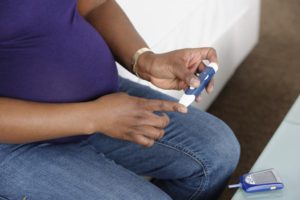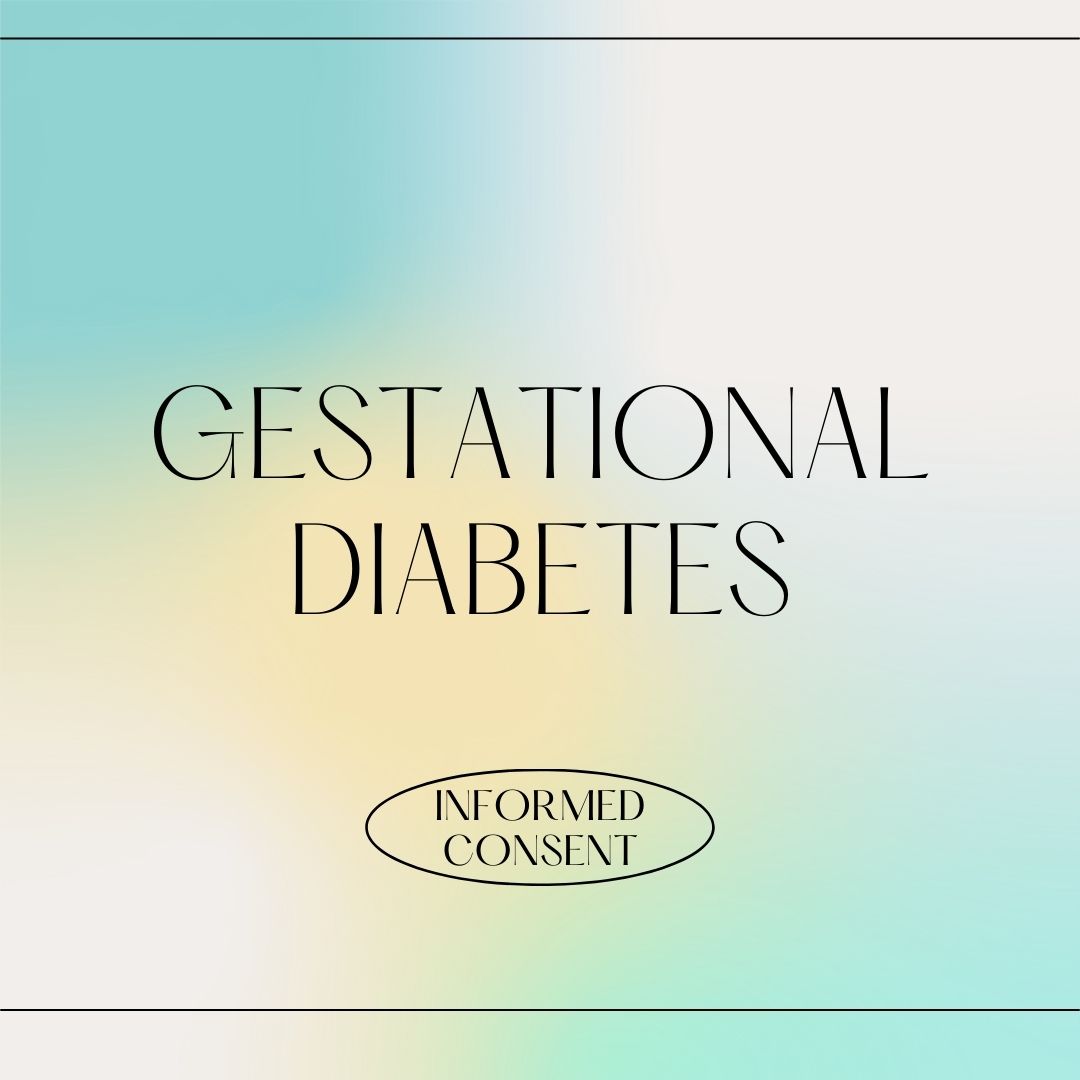Please read the disclaimer.
It is what it is.
It is standard practice in obstetrical and midwifery care to offer a Gestational Diabetes Screen at around 26-28 weeks of pregnancy. A screen determines if you are at risk for a condition. When the risk is determined, then a test will be performed to confirm the diagnosis. The GD screen consists of taking in 50 grams of sugar quickly, and having a blood draw to be analyzed an hour later. The 50 grams of sugar is usually in the form of the glucola drink. For perspective, Arizona Southern Brewed Sweet Tea has 43 grams of sugar and a Dr. Pepper has 66. You do not have to fast (go without food) for the screen. In fact, you are encouraged to eat and drink as you normally would.
Why it’s important!

Our bodies have evolved to nourish our babies before nourishing ourselves. Pregnancy hormones make it so that insulin, the hormone that regulates the sugar in our blood, is less effective. Our muscle and organ cells (including brain) become saturated with sugar so the nutrients we take in cannot get to them, and they go directly to the baby. This gives the babies an advantage for survival once they are born.
Compared to our ancestors, we who live in Western cultures usually have an overabundance of foods. Although we may be eating “healthy,” our pregnant bodies think we are still hunter/gatherers, and may be blocking our nutrient absorption in order to send more to our babies.
When our blood has too much sugar in it, our cells get to where they are unable to absorb any sugar for energy to function properly or absorb other nutrients to stay healthy. We become malnourished, and don’t feel well overall. Our babies get used to the constant high sugar dose and can crash after they are born when they no longer have access to it. They are extremely sleepy and don’t want to eat. They often need to be force-fed formula to get them to come around since most women do not have an ample supply of colostrum ( first milk, or pre-milk) pumped beforehand to get the baby through. Sleepy babies from a blood sugar crash after birth do not want to breastfeed. There are other serious complications that can arise for the mother and baby from Gestational Diabetes.
“I don’t like…”
There is a drink that is usually offered for the Gestational Diabetes Screen called glucola. It is a non-carbonated beverage with 50 grams of glucose. In my opinion, it tastes like flat soda with a little extra corn syrup. As a midwife, I have many clients that don’t like it as it makes them nauseas. I am comfortable with most any sugar load that equals 50 grams so we can get an accurate result of what the pregnant body is doing with sugars. My first choice is candy (Brach’s jelly beans, Twizzlers). Sucrose, the sugar in candy, is most closely related to glucose, the simplest sugar found in blood. Understand that it is 24 pieces jelly beans or 15 ropes of licorice to equal 50 grams. I have had feedback that it is too much candy to chew in a short amount of time, and the drink would have been easier to get down. My second choice is fructose, the sugar found in fruit and juice. It takes a little more to break down to simple sugar, but I believe it is close enough to give us an idea of what the body is actually doing. Again, getting enough sugar will take two single serving bottles for most juices.
What “I” don’t like.
 You may have read about the two hour post-prandial. This is when the midwife takes a fasting blood draw in the morning and sends you out to a pancake breakfast, then takes a blood draw to test in two hours, instead of one. The main argument is that it is important to see how you body reacts to food, not a sugar load, as most midwifery clients are healthy eaters and do not have excessive sugar in their diets. I would like to defer back to “Why it’s important!” above. This is not about diet. This is about determining if there is a risk of a metabolic condition that may negatively impact the mother, or her baby, or both. There is no measurement of how much sugar the woman is taking with the pancake breakfast. Therefore, the screen is skewed. I want to know if something is metabolically going on so I can make recommendations that work with your body to have a healthy pregnancy and healthy baby. I need accurate information to do so.
You may have read about the two hour post-prandial. This is when the midwife takes a fasting blood draw in the morning and sends you out to a pancake breakfast, then takes a blood draw to test in two hours, instead of one. The main argument is that it is important to see how you body reacts to food, not a sugar load, as most midwifery clients are healthy eaters and do not have excessive sugar in their diets. I would like to defer back to “Why it’s important!” above. This is not about diet. This is about determining if there is a risk of a metabolic condition that may negatively impact the mother, or her baby, or both. There is no measurement of how much sugar the woman is taking with the pancake breakfast. Therefore, the screen is skewed. I want to know if something is metabolically going on so I can make recommendations that work with your body to have a healthy pregnancy and healthy baby. I need accurate information to do so.
Another I option I hear discussed is to have an A1C. This is a blood sugar test that measures what a person’s average range has been over the last three months. It is a very important tool in diagnosing and monitoring Diabetes. However, it only tells me how a pregnant person has been metabolizing their sugars before or in early pregnancy, and I need to know how that body is managing in later pregnancy.
Other options?
 At home glucose monitoring is a good option for people who:
At home glucose monitoring is a good option for people who:
- Do not wish to undergo the 50 gram glucose screening.
- Are out of normal range for the 50 gram glucose screen.
- Are in normal range for the 50 gram glucose screen, but have symptoms of blood sugar problems.
- Are curious about their body’s tolerance to sugar in the diet.
There are two important types of readings gathered from at home monitoring, fasting glucose level and post-prandial (after meal) glucose level. To perform at-home blood glucose monitoring:
Test your blood glucose level upon waking but before eating. This reading should be BELOW 90. In a notebook, or a log provided by your midwife, or a downloaded app, record what you ate for breakfast, and ONE HOUR after you finish eating, test your blood glucose level again. This reading should be BELOW 140. Repeat this for lunch and dinner.
Call your midwife if you have two or more spikes (a reading above 120) at the same time of day within a three day period.
Some ways to ensure stable, good blood sugars:
- Eat as usual for the first few days to see what you’re already doing that works and doesn’t work.
- Don’t go more than two hours without eating something.
- If your fasting blood glucose levels are high, try adding a slow carb absorbing snack before bed. Some ideas are a glass of milk and a spoonful of peanut butter, a high-protein/low sugar smoothie. Think protein+fat+lactose.
- If you wake up in the night, eat a little something then too.
- Improve digestion. Consider adding digestive enzymes to your supplements.
- Add a 15 minute walk after meals. This has a direct effect on lowering your blood sugar levels, and is a constructive way to meet your exercise goals for your pregnancy.
- If none of these things work, be sure to check in frequently with your midwife.
This is a good way to see in real time how what you eat affects your blood sugars. People who keep their blood sugars stable throughout pregnancy enjoy the benefits of increased feeling of well-being, lower risk of developing gestational diabetes and preeclampsia, an appropriately sized baby at delivery, and less excess weight gain. Although pricking the finger four times a day is an irritation, the benefits outweigh the irritation.
UPDATE: There is a new product out called Fresh Test. It is a lemon flavored drink that contains 50 grams of glucose and is recognized as valid glucose load by Lab Corp, the lab I use. Clients say is is very palatable, tasting like a sweet lemonade. You can read more about Fresh Test on their website: https://thefreshtest.com/ END UPDATE.
FAIL!
 The Glucose Screen is not a test, and you can’t fail a screen! Having a high value from your screen may result from having some sweet tea before your appointment, or a Smoothie King for breakfast. Although, we want you to do what is normal for you in a typical day when you have your Gestational Diabetes Screen, be mindful of adding any extra sugar before your screen. 50 grams of glucose is not that much in context of the average diet, but let’s not artificially inflate it with a treat we don’t normally have.
The Glucose Screen is not a test, and you can’t fail a screen! Having a high value from your screen may result from having some sweet tea before your appointment, or a Smoothie King for breakfast. Although, we want you to do what is normal for you in a typical day when you have your Gestational Diabetes Screen, be mindful of adding any extra sugar before your screen. 50 grams of glucose is not that much in context of the average diet, but let’s not artificially inflate it with a treat we don’t normally have.
When the screen results are out of normal range, that means you are at risk for Gestational Diabetes. Then we do “The Glucose Tolerance Test” to determine if you have it or not. To be honest, the test is hard, pregnant or not! Schedule it first thing in the morning for it needs a fasting value (a blood draw before you have eaten anything that day). Then a blood draw is taken every hour on the hour three times. So, plan to be at the clinic for three hours! You can not eat or drink anything except small sips of water during this time. The glucose load is 100, compared to 50 from the screen. Expect to feel terrible, extremely tired, chills, etc. Bring a sweater or a blanket. Make a plan to eat after as soon as possible. You may need to plan for a nap afterward. Have someone else drive you. (I collect the sample for the screen during a routine prenatal visit in your home and deliver it to the lab. The test is performed at the lab by one of their technicians).
You got this!
 Many pregnant people who need to be tested for Gestational Diabetes after the screen will pass the test. However, when the results are within range, but borderline, that tells me that there may be a blood sugar issue going on, and I may want to do two weeks of blood sugar monitoring to see if any extra diet and exercise recommendations are appropriate. Remember, home birth is safe for low risk pregnancy, with a qualified attendant, and ready access to medical care when needed. When indicated, this is a way I help you remain low risk.
Many pregnant people who need to be tested for Gestational Diabetes after the screen will pass the test. However, when the results are within range, but borderline, that tells me that there may be a blood sugar issue going on, and I may want to do two weeks of blood sugar monitoring to see if any extra diet and exercise recommendations are appropriate. Remember, home birth is safe for low risk pregnancy, with a qualified attendant, and ready access to medical care when needed. When indicated, this is a way I help you remain low risk.
No thank you!
Some want to decline the screen altogether, and that is their right to do so. As a midwife, I fully support bodily autonomy and shared decision making when it comes to pregnancy health decisions. However, I am bound by my state’s governing body to have a Gestational Diabetes Screen performed and charted. If you decline the screen, I can not legally continue care.

Following the diet and exercise recommendations that keep blood sugar at moderate levels are something you can control. It doesn’t means there is anything wrong with you or your body. It means you have to work a little harder than most to stay low risk. Also, the recommendations are temporary, as the issue resolves once the baby is born. Then you may drink your sweet tea to your hearts content.
For more reading on Gestational Diabetes, screens and tests, and alternatives to the glucola drink, I recommend the article by Evidenced Based Birth.


